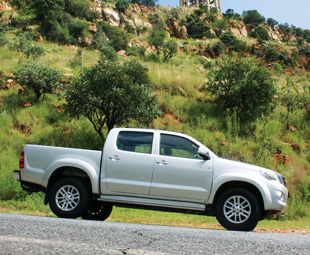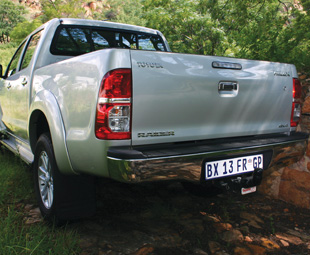Evading the lynch mob

It’s been the country’s best-selling bakkie – and one of its best-selling vehicles – for over 40 years, consistently. GAVIN MYERS sets out in the 3,0 D-4D 4×4 Raider to find out why.
Traditionally, the Mitsubishi Colt, Nissan Hardbody, Ford Ranger and Isuzu KB – good as they each were in their own right – could not really hold a candle to South Africa’s king of bakkies: the Hilux. However, in recent years the competition has come raving at the gates of Hilux Manor, with fire torches and pitchforks.
The new generation has upped the game; offering more size, more space, more comfort and more attitude. Not that this has stopped the Hilux from outselling its nearest rival 2:1. So what makes it so popular then?
It stems from the badge. Toyota and Hilux are names almost every South African holds in high regard; close to one million Hiluxes have been sold locally since its original introduction in 1969 … .
Being a Toyota it’s well built, everything feels solid and the build quality (apart from one misaligned dash panel) is fantastic. That said, the interior is showing its age now – the ergonomics aren’t the best and most of the plastics used feel hard and rough with some sharp edges.
 It can also be difficult to find an ideal driving position, partly due to the steering wheel being adjustable only for height and not reach. However, the big seats are very comfortable and interior space is good.
It can also be difficult to find an ideal driving position, partly due to the steering wheel being adjustable only for height and not reach. However, the big seats are very comfortable and interior space is good.
Despite the comfy seats, the rear suspension is horribly hard – on anything other than baby-bottom-smooth roads, the Hilux exhibits among the choppiest of rides I’ve experienced. Sure, this is to be expected, but here is yet another area where its new rivals have moved the goal posts.
Otherwise, the three-litre diesel does a good job of hauling the Hilux around, but feels less powerful than its 120 kW at 3 400 r/min and 343 Nm at 1 400 – 3 200 r/min might suggest. However, the torque band is sustained well throughout the rev range. Toyota claims combined fuel consumption of 8,6 l/100 km and carbon emissions of 226 g/km.
Manoeuvrability is hampered somewhat by the heavy steering and the much too narrow rear window – a problem particularly when reversing as it’s not low enough for the driver to see the extremities of the load bay.
The load bay itself measures 1 520 (l) x 1 515 (w) x 450 mm (h) and this model has a 2 740 kg Gross Vehicle Mass and 815 kg payload – all figures around class average.
Convenience features include: automatic air-conditioning; cruise control; trip computer; six-speaker touch-screen MP3 radio/CD player with auxiliary input and USB, as well as Bluetooth connectivity.
Among the safety items fitted are six airbags, anti-lock braking incorporating Electronic Brakeforce Distribution and Brake Assist as well as Toyota’s Vehicle Stability Control system.
The Toyota Hilux 3,0 D-4D 4×4 Raider Double Cab retails for R441 000 and comes with a three-year/100 000 km warranty and five-year/90 000 km service plan. It’s priced well, it feels hewn-from-rock solid and of course it’s a Toyota.
But does it still shine the leading light? It’s getting on in years, and stacked up against its direct rivals it does not necessarily offer as comprehensive a package as most of them do. The hard fact is: others in the new generation of double-cab bakkies are putting up a serious fight – their torches flaming wildly.
Published by
Focus on Transport
focusmagsa




